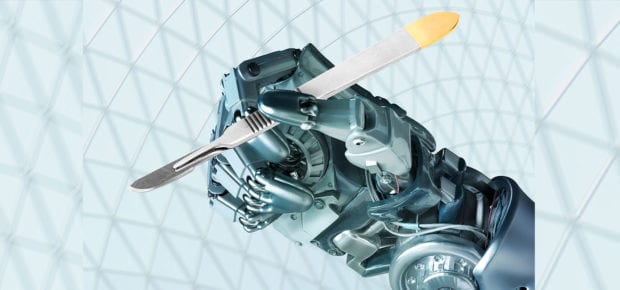November 18, 2019
The use of robotic arms, systems and devices for surgery began in the early 80s, yet their ability to assist surgeons with difficult tasks with greater accuracy is becoming an increasingly accepted practice in operating rooms across the globe.
As technology continues to grow and evolve, generations of people are becoming more open to these types of innovations being used for life-saving procedures. Millennial parents in Asia are significantly more likely than those parents surveyed in the U.S., U.K., Brazil, and India to allow robots powered by AI to conduct surgery on their Generation Alpha child — even more so in 2019 as compared to 2018, according to a new survey conducted by IEEE.
It’s no surprise the general population and medical professionals are increasingly warming up to the idea of robotic arms assisting in– or even leading — surgeries. Technologists are working hard to improve a robot’s efficiency and machine-learning capabilities so this type of technology in the operating room becomes the new norm.
“The impact of robotic systems and devices on surgery in the next 25 years promises to be as comparable to that of manufacturing robots on industrial production over the past 25 years,” reports the IEEE Robotics and Automation Society’s technical committee for surgical robots.
The Benefits of Robotic Arms for Surgery
The benefits of using a robotic arm, system or device during surgery will drastically change and impact how surgeons run their operating rooms in the future.
“By extending human surgeons’ ability to plan and carry out surgical interventions more accurately and less invasively, surgical robotic systems can address a vital international need to greatly reduce costs, improve clinical outcomes, and improve the efficiency of health care delivery,” notes the Robotics and Automation Society.
Essentially, robotic arms are capable of assisting in surgeries that were once seen as risky or complicated. Robots are beneficial because they are consistently more accurate and steady as compared to a human hand.
“Robotization allows the surgeons to perform highly complicated procedures with ease due to the increased dexterity coupled with advanced HD 3D vision and precise maneuverability,” says IEEE member Jayakrishnan T. Nair. “The system provides fully fledged real-time connectivity of the surgeon and the area under surgery in terms of visual, auditory, tactile and haptic means. Because of this, the application of robotics surgery is not just limited to joints and the abdomen but also to help procedures for the heart, brain, spine and almost everywhere.”
The Future of Robotic Surgery
While in the future robots may not just assist, but lead surgeries, it will take a while before all skills are left in the mechanical hands of a robotic device.
“At present almost all surgical robots are assistive and under the supervision of experienced surgeons,” says Nair. “However, it allows the surgeons to reduce failures. For example, a slippage of the hand can be protected through 3D imaging and augmented reality to avoid unwanted collisions in real time.”
Engineers are aware of the needs for technical innovation before the general population will fully trust a robotic surgeon. Future research efforts of IEEE Robotics and Automation Society members may address improving the simplicity of robotic use for minimally invasive surgery, new mechatronic hand-held tools capable of augmenting the performance of surgeons, new endoscopic robots and investigating new avenues of application in micro and nano surgery in the coming years.
While we may not see a completely robotic-led surgery anytime soon, technologists are working hard to innovate new technologies to change modern medicine as we know it.
“In the coming years, robotic surgery will undoubtedly find more advancement and significance,” says Nair.






 The Impact of Technology in 2025
The Impact of Technology in 2025 Quantum and AI: Safeguards or Threats to Cybersecurity?
Quantum and AI: Safeguards or Threats to Cybersecurity? Why AI Can't Live Without Us
Why AI Can't Live Without Us Bits, Bytes, Buildings and Bridges: Digital-Driven Infrastructure
Bits, Bytes, Buildings and Bridges: Digital-Driven Infrastructure Impact of Technology in 2024
Impact of Technology in 2024 Emerging AI Cybersecurity Challenges and Solutions
Emerging AI Cybersecurity Challenges and Solutions The Skies are Unlimited
The Skies are Unlimited Smart Cities 2030: How Tech is Reshaping Urbanscapes
Smart Cities 2030: How Tech is Reshaping Urbanscapes Impact of Technology 2023
Impact of Technology 2023 Cybersecurity for Life-Changing Innovations
Cybersecurity for Life-Changing Innovations Smarter Wearables Healthier Life
Smarter Wearables Healthier Life Infrastructure In Motion
Infrastructure In Motion The Impact of Tech in 2022 and Beyond
The Impact of Tech in 2022 and Beyond Cybersecurity, Technology and Protecting Our World
Cybersecurity, Technology and Protecting Our World How Technology Helps us Understand Our Health and Wellness
How Technology Helps us Understand Our Health and Wellness The Resilience of Humanity
The Resilience of Humanity Harnessing and Sustaining our Natural Resources
Harnessing and Sustaining our Natural Resources Creating Healthy Spaces Through Technology
Creating Healthy Spaces Through Technology Exceptional Infrastructure Challenges, Technology and Humanity
Exceptional Infrastructure Challenges, Technology and Humanity The Global Impact of IEEE's 802 Standards
The Global Impact of IEEE's 802 Standards Scenes of our Cyber Lives: The Security Threats and Technology Solutions Protecting Us
Scenes of our Cyber Lives: The Security Threats and Technology Solutions Protecting Us How Millennial Parents are Embracing Health and Wellness Technologies for Their Generation Alpha Kids
How Millennial Parents are Embracing Health and Wellness Technologies for Their Generation Alpha Kids Space Exploration, Technology and Our Lives
Space Exploration, Technology and Our Lives Global Innovation and the Environment
Global Innovation and the Environment How Technology, Privacy and Security are Changing Each Other (And Us)
How Technology, Privacy and Security are Changing Each Other (And Us) Find us in booth 31506, LVCC South Hall 3 and experience the Technology Moon Walk
Find us in booth 31506, LVCC South Hall 3 and experience the Technology Moon Walk Virtual and Mixed Reality
Virtual and Mixed Reality How Robots are Improving our Health
How Robots are Improving our Health IEEE Experts and the Robots They are Teaching
IEEE Experts and the Robots They are Teaching See how millennial parents around the world see AI impacting the lives of their tech-infused offspring
See how millennial parents around the world see AI impacting the lives of their tech-infused offspring Take the journey from farm to table and learn how IoT will help us reach the rising demand for food production
Take the journey from farm to table and learn how IoT will help us reach the rising demand for food production Watch technical experts discuss the latest cyber threats
Watch technical experts discuss the latest cyber threats Explore how researchers, teachers, explorers, healthcare and medical professionals use immersive technologies
Explore how researchers, teachers, explorers, healthcare and medical professionals use immersive technologies Follow the timeline to see how Generation AI will be impacted by technology
Follow the timeline to see how Generation AI will be impacted by technology Learn how your IoT data can be used by experiencing a day in a connected life
Learn how your IoT data can be used by experiencing a day in a connected life Listen to technical experts discuss the biggest security threats today
Listen to technical experts discuss the biggest security threats today See how tech has influenced and evolved with the Games
See how tech has influenced and evolved with the Games Enter our virtual home to explore the IoT (Internet of Things) technologies
Enter our virtual home to explore the IoT (Internet of Things) technologies Explore an interactive map showcasing exciting innovations in robotics
Explore an interactive map showcasing exciting innovations in robotics Interactively explore A.I. in recent Hollywood movies
Interactively explore A.I. in recent Hollywood movies Get immersed in technologies that will improve patients' lives
Get immersed in technologies that will improve patients' lives